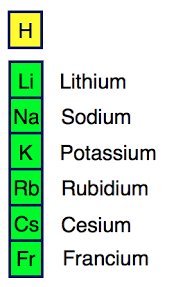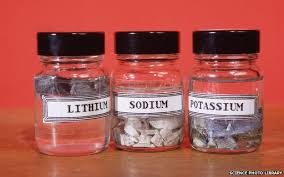Overview
The alkali metals are in Group 1 of the periodic table. They include the elements lithium (Li), sodium (Na), potassium (K), rubidium (Rb), cesium (Cs), and francium (Fr). These highly reactive elements form compounds easily and explosively. They all have one electron in their outermost shell, giving it up to form ionic compounds.
Lithium (Li)
Lithium is the lightest metal, with atomic number 3. It is so soft that it can be cut with a knife, although it is so reactive that it quickly oxidizes. It reacts with water to form lithium hydroxide (LiOH) in solution and free hydrogen. It is also very flammable, and is usually stored in petroleum jelly. Since lithium is so reactive, it is almost always found in various compounds. Lithium is used in batteries (including lithium-ion batteries), in ceramics and glass, in industrial lubricants, and as a catalyst in fusion reactions.
Sodium (Na) and Potassium (K)
Sodium (atomic number 11) and potassium (atomic number 19) are both fairly common elements. Both are even more reactive than lithium, and are also flammable. When sodium comes in contact with water, it produces flammable hydrogen and caustic sodium hydroxide. Therefore, it is usually stored in mineral oil. One of the most common compounds of sodium is table salt (NaCl), which is also an essential nutrient, necessary to plant and animal life. Potassium, its heavier cousin, is also essential to cell functioning. It forms similar chemical compounds to sodium. Potassium compounds are used in fertilizer, food, various dyes, and in potash.
Rubidium (Rb) and Cesium (Cs)
Rubidium (atomic number 37), like the other alkali metals, is highly reactive, flammable, and only occurs naturally in compounds. It is used in atomic clocks and laser cooling. One isotope of rubidium has specialized medical applications, such as PET scans. Particular types of tumors contain more rubidium than normal tissue, so they can be detected and destroyed. Cesium or caesium (atomic number 55) is liquid at about 83 degrees F., although it is not found as pure metal naturally. If cesium comes in contact with water, it explodes, and is so flammable in air that it can catch fire spontaneously. However, atomic clocks that use cesium are so accurate that they lose less than a second in 1.4 million years.
Francium (Fr)
Francium (atomic number 87) is radioactive, with a half-life of about 22 minutes. It is extremely rare because of its short half-life, and occurs naturally as a product of the decay of the element actinium. When francium was discovered in the laboratory, it was first mistaken for more common elements, but careful study by scientist Marguerite Perey showed it was a new element. Although she first isolated it in 1939, it has been synthesized by scientists since 1996 by bombarding a tiny gold target with beams of oxygen atoms emitted by a linear accelerator.
Interested in science tutoring services? Learn more about how we are assisting thousands of students each academic year.
SchoolTutoring Academy is the premier educational services company for K-12 and college students. We offer tutoring programs for students in K-12, AP classes, and college. To learn more about how we help parents and students in Mountain Home, ID: visit Tutoring in Mountain Home, ID




